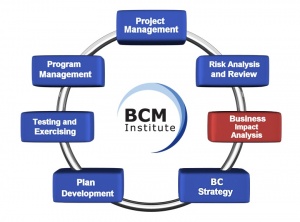Part 3: Impact Over Time of Business Functions v2.0
Part 4: Impact Over Time of Business Functions
Business Function and Function Code (Col 2 & 3)
- Cross-reference to the Business Function/function code or number from original Function No assigned in Part 1
Highest-Impact Area (Col 4)
- Highest-Impact Area refers to the impact area determined during Impact analysis in part 3 of the BIA Template
Impact Over Time (Col 5 to 16)
Based on the Descriptor for Impact Rating and Impact Area, indicate the degree of impact to the organization that will be caused by the unavailability of this business function at the respective time frames after taking into consideration the worst-case situation of both the financial and non-financial impacts. This will be based on a scale of 1 to 5 and the impact descriptor.
- The timescale for a business function to be carried out on a normal day. You can consider how long does it take to do one transaction. Insert the appropriate timescale found in the BIA Questionnaire.
- Example of a typical entry is “1” if the time scale is less than 4 hrs, “2” if less than 1 day. Refer to the scale found in Part 3.
Recovery Time Objective (RTO) (Col 17 to 18)
The period of time within which systems, applications, or functions must be recovered after a disruption has occurred. For the conduct of this Business Impact Analysis, the RTO is the point in time where the impact reaches a 3.
- Sometimes referred to as Disaster Timescale or Crisis Timeline
- During a disaster, would you be able to stretch the timescale during the delivery of this business function? Would your customer be able to bear with the delay?
- Please make a personal judgment based on a “credible” Worst Case Disaster Scenario.
- Could the business function be carried out over a longer period, possibly by using different means during a disaster?
- Assume it is not possible to access your office location.
Maximum Tolerable Period of Disruption (MTPD) (Col 19 to 20)
The Maximum Tolerable Period of Disruption (MTPD) is the time it would take for adverse impacts, which might arise as a result of not providing a product/service or performing a function, to become unacceptable. For the conduct of this Business Impact Analysis, the MPTD stands for the point in time where the impact reaches a 5.
- Maximum Tolerable Period of Disruption or MTPD is the maximum allowable time that the organization’s key products or services is made unavailable or cannot be delivered before its impact is deemed as unacceptable.
Vulnerable Period (Col 21)
Estimate and explain when is the function most critical. E.g. During a particular day of the week/ Week of the month/ Month of the year.
- State the specific time e.g.
- Month-end
- Year-end
- 25th of the month
- 4.30 pm daily
- Not applicable
- Specific when the business function is most vulnerable.
Notes
- Try to discourage answers such as “All day” and “Ad-hoc.”
- Try to give a definitive date instead of a range. For example, no 5 to 7 days
- Note that the key is to identify how much time it takes to complete a transaction and compare this with the time to be taken during a disaster.
Instruction to BL-B-3/5 M2 Participant
Refer to the text of each of the sections within this page which is highlighted in italics for further explanation when attempting the Module 2 assignment.




